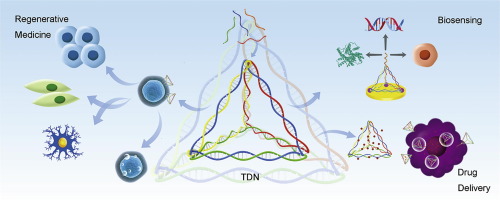当前位置:
X-MOL 学术
›
Mater. Today
›
论文详情
Our official English website, www.x-mol.net, welcomes your
feedback! (Note: you will need to create a separate account there.)
Advances in biological applications of self-assembled DNA tetrahedral nanostructures
Materials Today ( IF 21.1 ) Pub Date : 2019-04-01 , DOI: 10.1016/j.mattod.2018.08.002 Songhang Li , Taoran Tian , Tao Zhang , Xiaoxiao Cai , Yunfeng Lin
Materials Today ( IF 21.1 ) Pub Date : 2019-04-01 , DOI: 10.1016/j.mattod.2018.08.002 Songhang Li , Taoran Tian , Tao Zhang , Xiaoxiao Cai , Yunfeng Lin

|
Abstract In recent years, there has been a rapid progress in the development of DNA nanomaterials for biological applications. Owing to their unsurpassed editability, various DNA nanomaterials with well-documented biocompatibility and relative stability have been developed. Among these tetrahedral DNA nanostructures (TDNs), as typical multi-arm DNA tiles for 3D polyhedral, is a major research focus owing to their structural and biological features. TDNs have yielded satisfactory results as biological regulators, biosensors, and targeted delivery vehicles. Extensive studies on TDNs have revealed that TDNs alone could regulate several cellular processes, such as migration, proliferation, differentiation, and autophagy. Further, their editability enables control of the spatial distribution of biosensors, thereby promoting accuracy and efficiency. Finally, various modification procedures allow attachment of nucleic acids, aptamers, peptides, antibodies, and various low-molecular-weight drugs to the TDNs, thereby yielding a novel targeted delivery system. This review summarizes recent research progress on TDNs in these aforementioned major areas. These discoveries might be of great therapeutic value in regenerative medicine, gene delivery, targeted chemotherapy, and other related fields. We also illustrate the emerging challenges in the clinical application of TDNs, as well as future development opportunities.
中文翻译:

自组装DNA四面体纳米结构的生物学应用进展
摘要 近年来,用于生物应用的DNA纳米材料的开发取得了快速进展。由于其无与伦比的可编辑性,已开发出各种具有良好记录的生物相容性和相对稳定性的 DNA 纳米材料。在这些四面体 DNA 纳米结构 (TDN) 中,作为 3D 多面体的典型多臂 DNA 瓦片,由于其结构和生物学特征,成为主要研究焦点。TDN 作为生物调节剂、生物传感器和靶向递送载体已经取得了令人满意的结果。对 TDN 的广泛研究表明,仅 TDN 就可以调节多种细胞过程,如迁移、增殖、分化和自噬。此外,它们的可编辑性能够控制生物传感器的空间分布,从而提高准确性和效率。最后,各种修饰程序允许将核酸、适体、肽、抗体和各种低分子量药物连接到 TDN,从而产生新的靶向递送系统。本综述总结了 TDN 在上述主要领域的最新研究进展。这些发现可能在再生医学、基因传递、靶向化疗等相关领域具有重要的治疗价值。我们还说明了 TDN 临床应用中新出现的挑战,以及未来的发展机遇。本综述总结了 TDN 在上述主要领域的最新研究进展。这些发现可能在再生医学、基因传递、靶向化疗等相关领域具有重要的治疗价值。我们还说明了 TDN 临床应用中新出现的挑战,以及未来的发展机遇。本综述总结了 TDN 在上述主要领域的最新研究进展。这些发现可能在再生医学、基因传递、靶向化疗等相关领域具有重要的治疗价值。我们还说明了 TDN 临床应用中新出现的挑战,以及未来的发展机遇。
更新日期:2019-04-01
中文翻译:

自组装DNA四面体纳米结构的生物学应用进展
摘要 近年来,用于生物应用的DNA纳米材料的开发取得了快速进展。由于其无与伦比的可编辑性,已开发出各种具有良好记录的生物相容性和相对稳定性的 DNA 纳米材料。在这些四面体 DNA 纳米结构 (TDN) 中,作为 3D 多面体的典型多臂 DNA 瓦片,由于其结构和生物学特征,成为主要研究焦点。TDN 作为生物调节剂、生物传感器和靶向递送载体已经取得了令人满意的结果。对 TDN 的广泛研究表明,仅 TDN 就可以调节多种细胞过程,如迁移、增殖、分化和自噬。此外,它们的可编辑性能够控制生物传感器的空间分布,从而提高准确性和效率。最后,各种修饰程序允许将核酸、适体、肽、抗体和各种低分子量药物连接到 TDN,从而产生新的靶向递送系统。本综述总结了 TDN 在上述主要领域的最新研究进展。这些发现可能在再生医学、基因传递、靶向化疗等相关领域具有重要的治疗价值。我们还说明了 TDN 临床应用中新出现的挑战,以及未来的发展机遇。本综述总结了 TDN 在上述主要领域的最新研究进展。这些发现可能在再生医学、基因传递、靶向化疗等相关领域具有重要的治疗价值。我们还说明了 TDN 临床应用中新出现的挑战,以及未来的发展机遇。本综述总结了 TDN 在上述主要领域的最新研究进展。这些发现可能在再生医学、基因传递、靶向化疗等相关领域具有重要的治疗价值。我们还说明了 TDN 临床应用中新出现的挑战,以及未来的发展机遇。































 京公网安备 11010802027423号
京公网安备 11010802027423号